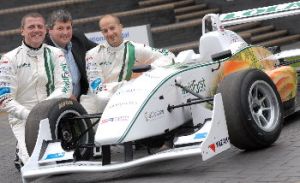Scavenged Carrots + Chocolate + Scrap Metal = Racecar
September 12, 2009 at 7:34 am | Posted in News | 1 Comment Researchers at Great Britain’s University of Warwick have unveiled what they’re calling the world’s greenest Formula 3 race car. Manufactured at a cost of £500,000 (aka nearly $1 million), able to reach speeds of 135 mph, and dubbed “WorldFirst,” the fully functional vehicle’s scavenged components include soda bottles, vegetable fiber, “waste chocolate,” flaxseeds, soybeans, and scrap metal, according to the business blog domain-b:
Researchers at Great Britain’s University of Warwick have unveiled what they’re calling the world’s greenest Formula 3 race car. Manufactured at a cost of £500,000 (aka nearly $1 million), able to reach speeds of 135 mph, and dubbed “WorldFirst,” the fully functional vehicle’s scavenged components include soda bottles, vegetable fiber, “waste chocolate,” flaxseeds, soybeans, and scrap metal, according to the business blog domain-b:
“Using recycled materials, and with support from over 50 companies, the design team headed by Dr Kerry Kirwan has created a car for just £500,000. And not just any old car, but a racing car capable of taking on the world’s finest.
“Unveiling his creation at the annual conference of the British Science Association, Dr Kirwan is confident that his innovative creation will not embarrass him. So confident, in fact, that he is entering his car in a Formula 3 championship race at the iconic Brands Hatch circuit in Kent….
“The car’s chassis has been reclaimed from a scrapped vehicle. So also its 2 litre BMW diesel engine, which was severely re-engineered so as to run on bio fuel. Recycled carbon fibres from old aircraft panels and recycled soft drink bottles that would otherwise have ended up in a landfill make up most of the vehicle’s body.
“Its steering wheel was manufactured by a company which uses carrot fibres, or cellulose nano-fibres, to give it its technical name, extracted from a carrot soup factory, with technology used to make fishing rods and other products. Curiously, the steering wheel is purple, instead of orange, which leads Dr Kirwan to speculate that beet fibres may have been added to the mix.
“For safety reasons, the wheels, tyres, and the cockpit had to remain conventional, and conform to rigid Formula 3 specifications. So, sadly, wheels made from recycled potato starch and brake pads from cashew nut shells had to be discarded in the design lab. The racing seat though, was made from flax fibre and soybean oil foam….
“Fuel efficient, as befits a ‘green’ vehicle, the car gives 35 miles to a gallon at race speeds. It has been engineered to run on any biodiesel, but so far, the team has been running it on fuel made from waste fat from a chocolate factory, and alcohol distilled from wine dregs. It is difficult to make a racing car that is ultimately sustainable, but Dr Kirwan thinks that this is a step in the right direction.
“Formula 1 racing has long been hated by environmentalists for its polluting ways. This car may be the first step to show people that environmental awareness has its place in motor racing. And this is not all. Some of the technology used in the design of WorldFirst could be successfully transferred to make ordinary cars more sustainable. In fact, Dr Kirwan is in talks to build yachts using recycled carbon fibre. To him, the car was a nice way of packaging up research in a credible way. His team and he hope to show the industry how much is possible using sustainable technologies.”
Warwick University’s website has more pictures of the car.
Create a free website or blog at WordPress.com.
Entries and comments feeds.
